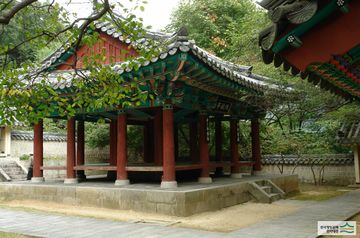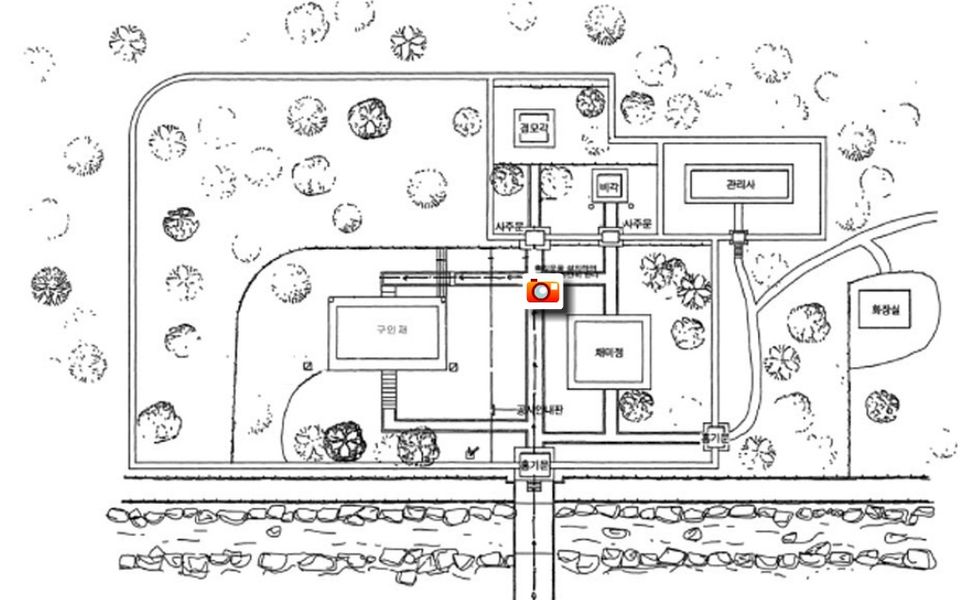구미 채미정
| 구미 채미정 Chaemijeong Pavilion, Gumi |
|
 "구미 채미정", 디지털구미문화대전, 한국학중앙연구원. |
|
| 대표명칭 | 구미 채미정 |
|---|---|
| 영문명칭 | Chaemijeong Pavilion, Gumi |
| 한자 | 龜尾 採薇亭 |
| 주소 | 경상북도 구미시 남통동 249번지 |
| 지정(등록) 종목 | 명승 제52호 |
| 지정(등록)일 | 2008년 12월 26일 |
| 분류 | 자연유산/명승/역사문화명승/ |
| 시대 | 조선시대 |
| 수량/면적 | 56,603㎡(지정구역) |
| 웹사이트 | 구미 채미정, 국가문화유산포털, 문화재청. |
|
|
|
해설문
국문
이 건물은 야은 길재(冶隱 吉再, 1353~1419) 선생의 충절과 학문을 추모하기 위하여 조선 영조(英祖) 44년(1768)에 건립한 정자이다.
야은 선생은 고려시대인 1386년에 문과에 급제하고 성균관 박사를 거쳐 문하주서(門下注書)1)에 올랐다. 고려가 망하고 조선 왕조가 들어서면서 두 왕조를 섬길 수 없다 하여 벼슬을 마다하고 선산(善山)에 머무르며 고려왕조에 대한 도리를 지켰다.
‘채미’라는 이름은 야은 선생이 고려 왕조에 절의를 지킨 것을 중국의 충신 백이(佰夷) 숙제(叔薺)가 고사리를 캐던 고사에 비유하여 지은 것이다. 채미정은 흥기문(興起門)을 지나 우측에 있는 정면 3칸, 측면 3칸 규모의 팔작지붕집이다. 뒤편에는 야은 선생의 충성스러운 마음을 기린 숙종(肅宗)의 ‘어필오언구(御筆五言句)2),가 있는 경모각(敬慕閣)과 유허비각(遺墟碑閣)3)이 나란히 자리 잡고 있다.
- 문하주서門下注書: 고려 시대에, 문하부에 속하여 문서 또는 기록을 맡아보던 종칠품 벼슬.
- 어필오언구: 임금이 쓴 시
- 유허비각: 야은 선생을 기리는 비
영문
Chaemijeong Pavilion, Gumi
This pavilion was built in 1768 to honor the loyalty and scholarship of Gil Jae (1353-1419), a great Confucian scholar who lived at the turn of the Goryeo (918-1392) and Joseon (1392-1910) periods.
Gil Jae passed the state examination in 1386 and served various official posts. When Goryeo fell and the Joseon dynasty was established, he could not be loyal to two kings, and so he refused to serve any public posts and stayed in his hometown of Gumi, where he dedicated himself to studying and teaching.
“Chaemi” in the pavilion’s name, meaning “digging up ferns,” comes from the classic Chinese story of two brothers, Boyi and Shuqi. When the Shang dynasty (16th C. BCE-1046 CE) was conquered by the Zhou dynasty (1046 BCE-256 CE), they refused to eat the farmed crops of the new dynasty. So, they led a secluded life in the mountains where they dug up and ate wild fiddlehead ferns, but eventually starved to death. Both of them are regarded as a symbol of dynastic loyalty.
To the left of Chaemijeong Pavilion is the Guinjae Hall, which was used by Gil Jae for teaching his students. Behind Chaemijeong Pavilion, there is a pavilion which houses a commemorative stele honoring his life and achievements. Another building behind this pavilion enshrines a poem praising Gil Jae's loyalty that was composed and calligraphed by King Sukjong (r. 1674-1720), the 19th king of the Joseon dynasty.
영문 해설 내용
이 정자는 고려말 조선초의 학자인 길재(1353-1419)의 충절과 학문을 추모하기 위해 1768년에 건립하였다.
길재는 1386년에 과거에 급제하여 여러 관직을 역임하였다. 고려가 멸망하고 조선왕조가 들어서자, 두 왕조를 섬길 수 없다 하여 벼슬을 마다하고 고향인 구미에 머무르며 학문과 후학양성에 힘썼다.
정자의 이름인 ‘채미’는 ‘고사리를 캔다’는 뜻으로, 중국의 고사에서 유래되었다. 상나라의 인물인 백이와 숙제 형제는 주나라가 상나라를 정벌하자, 주나라의 곡식을 먹을 수 없다며 산속에 은거하며 고사리를 캐어 먹다가 굶어 죽었다고 한다. 두 사람은 절의의 상징으로 여겨졌다.
채미정 왼쪽에 있는 구인재는 길재가 강학하던 공간이다. 채미정 뒤에는 길재를 기리는 비를 모신 비각이 있다. 비각 뒤의 건물에는 조선 제19대왕인 숙종(재위 1674-1720)이 길재의 충성을 칭송하여 지은 시를 보관하고 있다.
갤러리
구미 채미정 배치도[1]
참고
- "충절의 인물 야은 길재선생과 채미정", 뉴스풀 경북미디어센터, 2014.07.14.
- "Boyi and Shuqi", Wikipedia.
